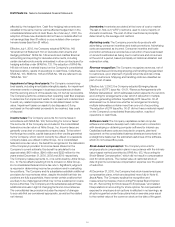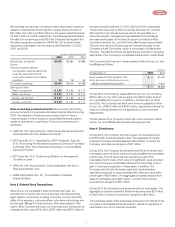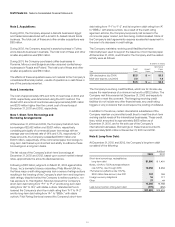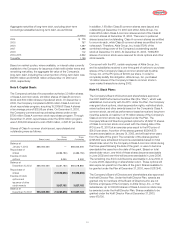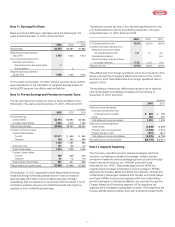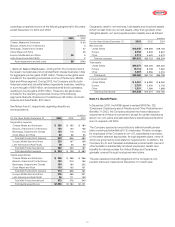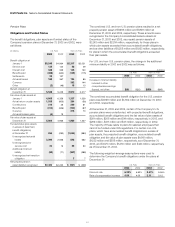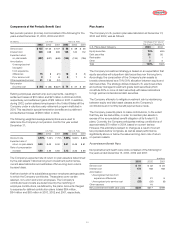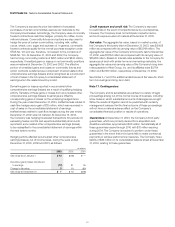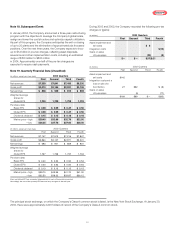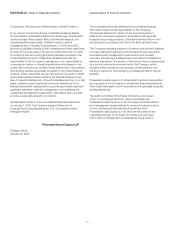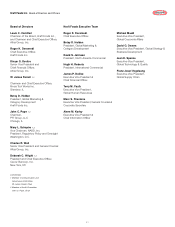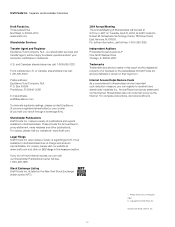Kraft 2003 Annual Report Download - page 58
Download and view the complete annual report
Please find page 58 of the 2003 Kraft annual report below. You can navigate through the pages in the report by either clicking on the pages listed below, or by using the keyword search tool below to find specific information within the annual report.
56
Kraft Foods Inc. Notes to Consolidated Financial Statements
During 2002, certain salaried employees in the United States left the
Company under a voluntary early retirement program instituted in
2001. This resulted in curtailment losses of $16 million in 2002, which
are included in other expense, above.
In December 2003, the United States enacted into law the Medicare
Prescription Drug, Improvement and Modernization Act of 2003
(the “Act”). The Act establishes a prescription drug benefit under
Medicare, known as “Medicare Part D,” and a federal subsidy to
sponsors of retiree health care benefit plans that provide a benefit
that is at least actuarially equivalent to Medicare Part D.
In January 2004, the FASB issued FASB Staff Position No. 106-1,
“A ccounting and Disclosure Requirements Related to the Medicare
Prescription Drug, Improvement and Modernization Act of 2003”
(“FSP 106-1”). The Company has elected to defer accounting for
the effects of the Act, as permitted by FSP 106-1. Therefore, in
accordance with FSP 106-1, the Company’s accumulated
postretirement benefit obligation and net postretirement health
care costs included in the consolidated financial statements and
accompanying notes do not reflect the effects of the Act on the
plans. Specific authoritative guidance on the accounting for the
federal subsidy is pending, and that guidance, when issued, could
require the Company to change previously reported information.
The following weighted-average assumptions were used to
determine the Company’s net postretirement cost for the years
ended December 31:
U.S. Plans Canadian Plans
2003 2002 2001 2003 2002 2001
Discount rate 6.50% 7.00% 7.75% 6.75% 6.75% 7.00%
Health care cost
trend rate 8.00 6.20 6.80 7.00 8.00 9.00
The Company’s postretirement health care plans are not funded.
The changes in the accumulated benefit obligation and net amount
accrued at December 31, 2003 and 2002, were as follows:
(in millions)
2003 2002
Accumulated postretirement benefit obligation
at January 1 $2,712 $2,436
Service cost 41 32
Interest cost 173 168
Benefits paid (189) (199)
Curtailments 21
Plan amendments (28) (164)
Currency 18
Assumption changes 174 193
Actuarial losses 54 225
Accumulated postretirement benefit obligation
at December 31 2,955 2,712
Unrecognized actuarial losses (1,064) (848)
Unrecognized prior service cost 202 197
Accrued postretirement health care costs $2,093 $2,061
The current portion of the Company’s accrued postretirement health
care costs of $199 million and $172 million at December 31, 2003 and
2002, respectively, are included in other accrued liabilities on the
consolidated balance sheets.
The following weighted-average assumptions were used to
determine the Company’s postretirement benefit obligations at
December 31:
U.S. Plans Canadian Plans
2003 2002 2003 2002
Discount rate 6.25% 6.50% 6.50% 6.75%
Health care cost trend rate
assumed for next year 10.00 8.00 8.00 7.00
Ultimate trend rate 5.00 5.00 5.00 4.00
Year that the rate reaches
the ultimate trend rate 2006 2006 2010 2006
Assumed health care cost trend rates have a significant effect on the
amounts reported for the health care plans. A one-percentage-point
change in assumed health care cost trend rates would have the
following effects as of December 31, 2003:
One-Percentage- One-Percentage-
Point Increase Point Decrease
Effect on total of service and
interest cost 14.0% (11.2)%
Effect on postretirement
benefit obligation 10.2 (8.5)
Postemployment Benefit Plans
Kraft and certain of its affiliates sponsor postemployment benefit
plans covering substantially all salaried and certain hourly
employees. The cost of these plans is charged to expense over the
working lives of the covered employees. Net postemployment costs
consisted of the following for the years ended December 31, 2003,
2002 and 2001:
(in millions)
2003 2002 2001
Service cost $10 $19 $20
Amortization of unrecognized net gains (5) (7) (8)
Other expense 123
Net postemployment costs $6 $35 $12
During 2002, certain salaried employees in the United States left the
Company under voluntary early retirement and integration programs.
These programs resulted in incremental postemployment costs of
$23 million, which are included in other expense, above.


